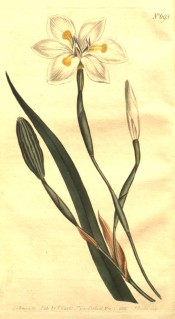Dietes iridioides (L.) Sweet ex Klatt
Very hardy, evergreen, rhizomatous, iris-like plant with a fan of basal leaves and white flowers, with yellow marks, in spring and summer. Individual flowers last only one day but continue in succession for many weeks. To 60cm. [RHSE, Hortus, CECB].
Horticultural & Botanical History
‘Found by Thunberg in the interior of the Cape country in Hottentot’s Holland, in a wood not far from Sea-Cow River, near a house called Kock’s-Farm. Cultivated by Miller in 1758, who received the seeds from the Cape, under the title of “White Water-Lily”; it is of the easiest culture, and will grow many years together (without parting or removing) in the same pot; requires plenty of water; blooms several weeks in succession during the Summer months,; produces seed in abundance; owing to which and its long standing in the country it is now one of the commonest of its tribe in our collections; has no smell.
Our drawing was taken at the Botanic Gardens, Brompton. We are rather surprised it has not before been discovered to be the same with Thunberg’s Iris compressa; his description is full and correct.’ [BM t.693/1803].
History at Camden Park
Listed only in the 1857 catalogue [B.107/1857]. Naturalised at Camden Park. It has been widely planted in Australia as a hardy, trouble-free, drought resistant plant and is now a significant weed in parts.
Notes
Published Oct 19, 2009 - 04:47 PM | Last updated Jul 23, 2010 - 11:52 AM
| Family | Iridaceae |
|---|---|
| Category | |
| Region of origin | South Africa, Cape district |
| Synonyms |
|
| Common Name | African iris, Cape iris, Fortnight lily |
| Name in the Camden Park Record | Dietes Iridoides |
| Confidence level | high |
